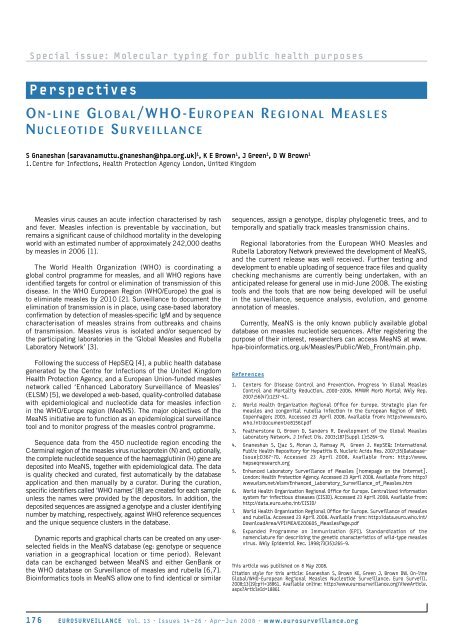In this edition Also - Eurosurveillance
In this edition Also - Eurosurveillance
In this edition Also - Eurosurveillance
Create successful ePaper yourself
Turn your PDF publications into a flip-book with our unique Google optimized e-Paper software.
Special issue: Molecular typing for public health purposes<br />
Perspectives<br />
O n-l i n e Gl O b a l /WHO-eu r O p e a n re G i O n a l Me a s l e s<br />
n u c l e O t i d e su r v e i l l a n c e<br />
S Gnaneshan (saravanamuttu.gnaneshan@hpa.org.uk) 1 , K E Brown 1 , J Green 1 , D W Brown 1<br />
1. Centre for <strong>In</strong>fections, Health Protection Agency London, United Kingdom<br />
Measles virus causes an acute infection characterised by rash<br />
and fever. Measles infection is preventable by vaccination, but<br />
remains a significant cause of childhood mortality in the developing<br />
world with an estimated number of approximately 242,000 deaths<br />
by measles in 2006 [1].<br />
The World Health Organization (WHO) is coordinating a<br />
global control programme for measles, and all WHO regions have<br />
identified targets for control or elimination of transmission of <strong>this</strong><br />
disease. <strong>In</strong> the WHO European Region (WHO/Europe) the goal is<br />
to eliminate measles by 2010 [2]. Surveillance to document the<br />
elimination of transmission is in place, using case-based laboratory<br />
confirmation by detection of measles-specific IgM and by sequence<br />
characterisation of measles strains from outbreaks and chains<br />
of transmission. Measles virus is isolated and/or sequenced by<br />
the participating laboratories in the ‘Global Measles and Rubella<br />
Laboratory Network’ [3].<br />
Following the success of HepSEQ [4], a public health database<br />
generated by the Centre for <strong>In</strong>fections of the United Kingdom<br />
Health Protection Agency, and a European Union-funded measles<br />
network called ‘Enhanced Laboratory Surveillance of Measles’<br />
(ELSM) [5], we developed a web-based, quality-controlled database<br />
with epidemiological and nucleotide data for measles infection<br />
in the WHO/Europe region (MeaNS). The major objectives of the<br />
MeaNS initiative are to function as an epidemiological surveillance<br />
tool and to monitor progress of the measles control programme.<br />
Sequence data from the 450 nucleotide region encoding the<br />
C-terminal region of the measles virus nucleoprotein (N) and, optionally,<br />
the complete nucleotide sequence of the haemagglutinin (H) gene are<br />
deposited into MeaNS, together with epidemiological data. The data<br />
is quality checked and curated, first automatically by the database<br />
application and then manually by a curator. During the curation,<br />
specific identifiers called ‘WHO names’ [8] are created for each sample<br />
unless the names were provided by the depositors. <strong>In</strong> addition, the<br />
deposited sequences are assigned a genotype and a cluster identifying<br />
number by matching, respectively, against WHO reference sequences<br />
and the unique sequence clusters in the database.<br />
Dynamic reports and graphical charts can be created on any userselected<br />
fields in the MeaNS database (eg: genotype or sequence<br />
variation in a geographical location or time period). Relevant<br />
data can be exchanged between MeaNS and either GenBank or<br />
the WHO database on Surveillance of measles and rubella [6,7].<br />
Bioinformatics tools in MeaNS allow one to find identical or similar<br />
sequences, assign a genotype, display phylogenetic trees, and to<br />
temporally and spatially track measles transmission chains.<br />
Regional laboratories from the European WHO Measles and<br />
Rubella Laboratory Network previewed the development of MeaNS,<br />
and the current release was well received. Further testing and<br />
development to enable uploading of sequence trace files and quality<br />
checking mechanisms are currently being undertaken, with an<br />
anticipated release for general use in mid-June 2008. The existing<br />
tools and the tools that are now being developed will be useful<br />
in the surveillance, sequence analysis, evolution, and genome<br />
annotation of measles.<br />
Currently, MeaNS is the only known publicly available global<br />
database on measles nucleotide sequences. After registering the<br />
purpose of their interest, researchers can access MeaNS at www.<br />
hpa-bioinformatics.org.uk/Measles/Public/Web_Front/main.php.<br />
References<br />
1. Centers for Disease Control and Prevention. Progress in Global Measles<br />
Control and Mortality Reduction, 2000-2006. MMWR Morb Mortal Wkly Rep.<br />
2007;56(47):1237-41.<br />
2. World Health Organization Regional Office for Europe. Strategic plan for<br />
measles and congenital rubella infection in the European Region of WHO.<br />
Copenhagen; 2003. Accessed 23 April 2008. Available from: http://www.euro.<br />
who.int/document/e81567.pdf<br />
3. Featherstone D, Brown D, Sanders R. Development of the Global Measles<br />
Laboratory Network. J <strong>In</strong>fect Dis. 2003;187(Suppl 1):S264-9.<br />
4. Gnaneshan S, Ijaz S, Moran J, Ramsay M, Green J. HepSEQ: <strong>In</strong>ternational<br />
Public Health Repository for Hepatitis B. Nucleic Acids Res. 2007;35(Database-<br />
Issue):D367-70. Accessed 23 April 2008. Available from: http://www.<br />
hepseqresearch.org<br />
5. Enhanced Laboratory Surveillance of Measles [homepage on the <strong>In</strong>ternet].<br />
London: Health Protection Agency. Accessed 23 April 2008. Available from: http://<br />
www.elsm.net/elsm/Enhanced_Laboratory_Surveillance_of_Measles.htm<br />
6. World Health Organization Regional Office for Europe. Centralized information<br />
system for infectious diseases (CISID). Accessed 23 April 2008. Available from:<br />
http://data.euro.who.int/CISID/<br />
7. World Health Organization Regional Office for Europe. Surveillance of measles<br />
and rubella. Accessed 23 April 2008. Available from: http://data.euro.who.int/<br />
DownloadArea/VPI/MEA/E200605_MeaslesPage.pdf<br />
8. Expanded Programme on Immunization (EPI). Standardization of the<br />
nomenclature for describing the genetic characteristics of wild-type measles<br />
virus. Wkly Epidemiol Rec. 1998;73(35):265-9.<br />
This article was published on 8 May 2008.<br />
Citation style for <strong>this</strong> article: Gnaneshan S, Brown KE, Green J, Brown DW. On-line<br />
Global/WHO-European Regional Measles Nucleotide Surveillance. Euro Surveill.<br />
2008;13(19):pii=18861. Available online: http://www.eurosurveillance.org/ViewArticle.<br />
aspx?ArticleId=18861<br />
176 EUROSURVEILLANCE Vol. 13 · Issues 14–26 · Apr–Jun 2008 · www.eurosurveillance.org

















